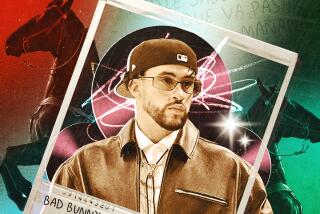Review: Live turkeys and dead televisions in Wolf Vostell’s exhibit
Signing a liability waiver and putting on disposable shoe covers are requisite preliminaries to viewing Wolf Vostell’s installation at the Box. They act as a kind of spectator foreplay, setting the mood for something risky, visceral, vulnerable. Even if we don’t quite know what, something is clearly at stake here.
Booties on and future claims waived, visitors enter a large room through a chain-link gate. The enclosure is a cage and also a graveyard of sorts. Roughly 40 old, boxy television sets are aligned in a loose maze.
Some sit directly on the floor. Some rest on tables, desks or chairs. Many of the sets are missing backs or sides, exposing their rusted guts. A few are turned on, to static. Some are partially embedded in neat blocks of concrete. Others have been smeared with the stuff, their screens thickly encrusted.
PHOTOS: Arts and culture by The Times
Meandering among and atop the furnishings are six domesticated turkeys, two male and four female. They strut through the sawdusted aisles and interstices, pecking at grain that has been scattered about. They warble and gobble, ruffle their feathers, approach and recede.
As much situation as scene, the piece makes participants out of every viewer. The experience is curious, and also thought-provoking. It’s an act of dynamic engagement to move among the living and dead components of the installation, to physically negotiate a position between boob tubes and turkeys, both as commonly associated with stupidity as with American cultural identity. The piece continually performs itself. We perform it.
Vostell (1932-98), a pioneer of the Happening and a co-founder of Fluxus, was committed to compressing the distance between art and life. Starting in the late ‘50s, he and his aesthetic comrades (Kaprow, Paik, Maciunas and others) aimed to de-commodify art, bring it more into the realm of daily occurrence, infuse it with chance, maybe elevate consciousness a little along the way. The German-born Vostell painted, made videos, sculptures and installations.
This piece, obtusely titled “Endogen Depression,” was first enacted in Hanover, Germany, in 1975. Over the years, it was staged in Italy, France, Spain and Portugal, and in 1980 it made its sole U.S. appearance at the Los Angeles Institute of Contemporary Art. Each iteration differed slightly in the number and configuration of components. Context surely affected the interpretation of the work, which initially incorporated dogs instead of turkeys, and was staged outdoors at least once.
One of the most endearing and enduring legacies of the Fluxus generation is the thread of self-reflexive humor that winds through their myriad activities. They made good on the belief that improvisation, accident and the ridiculous have their rightful place in art as in life.
Indeed, Vostell puts us in a relic-strewn cage with live turkeys--amusing, absolutely, but also surprisingly moving and even a bit haunting.
ALSO:
Best of 2013: Christopher Knight’s art picks
Barbra Streisand on Bette Midler’s performance as Sue Mengers
A new L.A. identity takes shape in 2013 as city embraces urban life
The Box, 805 Traction Ave., (213) 625-1747, through Jan. 5. Closed Monday and Tuesday. www.theboxla.com
More to Read
The biggest entertainment stories
Get our big stories about Hollywood, film, television, music, arts, culture and more right in your inbox as soon as they publish.
You may occasionally receive promotional content from the Los Angeles Times.






